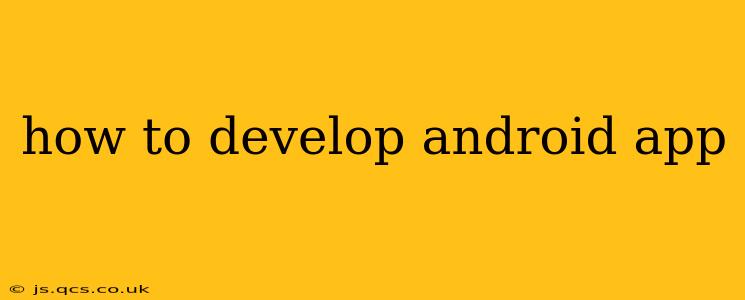Developing an Android app can seem daunting, but with the right approach and resources, it's achievable. This comprehensive guide breaks down the process, from initial concept to deployment on the Google Play Store. We'll cover everything from choosing the right tools to mastering key development concepts.
What You'll Need to Get Started
Before diving into the code, you need the right foundation. This includes:
- A Computer: A reasonably powerful computer (Windows, macOS, or Linux) is essential. Ensure it meets the minimum system requirements for Android Studio.
- Android Studio: This is the official Integrated Development Environment (IDE) for Android app development. It provides all the tools you need, including an emulator for testing your app. Download it from the official Android Developers website.
- Java or Kotlin Knowledge: While you can use other languages, Java and Kotlin are the most common for Android development. A solid understanding of programming concepts is crucial. Numerous online resources offer courses for both languages.
- An Idea: Start with a clear concept for your app. What problem will it solve? What features will it offer? A well-defined idea makes the development process much smoother.
Choosing Your Development Language: Java vs. Kotlin
Both Java and Kotlin are excellent choices for Android development. Kotlin, a more modern language, is officially supported by Google and offers several advantages, including:
- Conciseness: Kotlin code tends to be shorter and more readable than Java code.
- Null Safety: Kotlin's built-in null safety features help prevent null pointer exceptions, a common source of errors.
- Interoperability: Kotlin interoperates seamlessly with Java code, so you can use existing Java libraries in your Kotlin projects.
The Android App Development Process: A Step-by-Step Guide
-
Conceptualization and Planning: Define your app's purpose, target audience, and key features. Create wireframes or mockups to visualize the app's user interface (UI).
-
Setting up the Development Environment: Install Android Studio and configure it according to your system. Choose your preferred language (Java or Kotlin).
-
Designing the User Interface (UI): Use XML to design the layouts of your app's screens. Focus on creating an intuitive and visually appealing user experience.
-
Writing the Code (Logic): This is where you implement the app's functionality. This involves handling user input, processing data, and interacting with the operating system.
-
Testing: Thoroughly test your app on various devices and Android versions to identify and fix bugs. Use the Android emulator in Android Studio or connect a physical device for testing.
-
Deployment: Once you're satisfied with your app, prepare it for release on the Google Play Store. This includes creating an account, setting up your app's listing, and uploading the app's release build.
What are the different types of Android apps?
Android apps come in many forms, catering to various needs and functionalities. Some examples include:
- Native Apps: Built using Java or Kotlin and optimized for the Android platform. These offer the best performance and access to device features.
- Hybrid Apps: Developed using frameworks like React Native or Ionic, combining web technologies with native elements. These offer cross-platform compatibility but might have performance limitations.
- Web Apps: Accessed through a web browser on an Android device. They are easily accessible but lack direct access to device features.
How long does it take to develop an Android app?
The development time varies greatly depending on the app's complexity. A simple app could take weeks, while a complex app with many features might take months or even years.
What are the costs involved in developing an Android app?
Costs depend on the app's complexity, the developer's hourly rate, and any third-party services or tools used. You might need to factor in costs for design, development, testing, and deployment.
What are some popular Android app development frameworks?
Besides Java and Kotlin, several popular frameworks simplify the development process:
- React Native: Allows building cross-platform apps using JavaScript.
- Flutter: Uses Dart and offers a fast development cycle and high performance.
- Ionic: A hybrid framework enabling cross-platform development using web technologies.
This guide provides a solid foundation for your Android app development journey. Remember to break down the process into manageable steps, leverage available resources, and persistently learn and adapt as you progress. Good luck!
